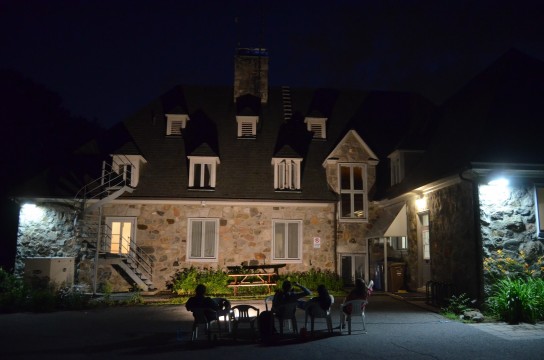As the sun sets over Pain de Sucre, the team gathers at the shores of Lac Hertel, notebooks and headlamps in hand. Soon, they will be able to witness the display of flying mammals. They spread around the historic Gault House to have a complete view of its slate roof. Their task for the night? Counting the number of bats using the attic of the historic Gault House as a maternity – a place to give birth and raise their young. After a few moments of waiting, a voice is heard on the radio, “Oh! We have one.”

Counting bats
Counting bats may sound complicated, but it is quite easy if you pay attention to their behaviour. Bats, like most animals, are creatures of habit. Every night, around sunset, bats will leave their roost to hunt. These outings can last many hours, as bats whiz through the air, searching for insects using echolocation.
Bats typically use the same entry and exit points. By observing these “doors”, we can count the number of bats leaving for their nightly hunt. They won’t return for a few hours, there is no risk of counting a bat twice. When they stop coming out, the field assistants wrap up for the night.
Only mature bats hunt at night. In the early summer, the field assistants are counting adult bats. By the end of the summer, the bats born that year are mature enough to leave the attic. This helps the field assistants see how successful the mothers were in raising their young.

Big brown bats (Eptesicus fuscus), like the one pictured, have established a maternity site in the attic of Gault House many years ago (photo: (c) stephen_buckingham, some rights reserved (CC BY-NC))
Why protect and monitor bat maternities?
Bats are crucial to Gault Nature Reserve’s ecosystem because they eat insects. By consuming large numbers of them, they help maintain balance and reduce the quantity of biting flies and mosquitoes. Preserving this bat roost is vital for the bats and the overall health of the Reserve's environment.
Unfortunately, bats across North America are threatened by a fungal disease known as white-nose syndrome. This disease has decimated once-abundant species like the little brown bat (Myotis lucifugus). Since its discovery in 2006, white-nose syndrome has killed millions of bats. The disease causes white fungal growths on hibernating bats’ noses, wings, and ears. This disrupts their hibernation, causing them to wake often. As a result, they deplete their fat reserves, which often leads to starvation.
The big brown bats found in Gault House were not as heavily impacted by the white-nose syndrome. However, they still face other threats such as habitat destruction and pesticide use. It is welcome news that many of them have been breeding and raising their young in the attic of Gault House.

A great heron (Ardea herodias) hunts on the shore of Lac Hertel (photo: Alex Tran)
As the summer progresses, the field assistants will return to the shores of Lac Hertel to watch over the maternity. “I love bats and am excited to see them again,” said Sophie. Our team hopes the bat population stays stable and that many young bats are born. One thing is certain: the interns will keep an eye on the sky, watching over our little winged friends.
Get involved
These counts are part of the Neighbourhood Bat Watch project. Canadians can take part by locating and monitoring buildings where bats live. By doing so, we can all support bat conservation.
Read also
Notes From the Field: The prickly problem of invasive plant species
This summer, the interns at Gault are working on inventorying and clearing invasive plant species found on the mountain. In doing so, they aim to relieve some of the strain caused by these invasions on the ecosystems of Mont Saint-Hilaire.



